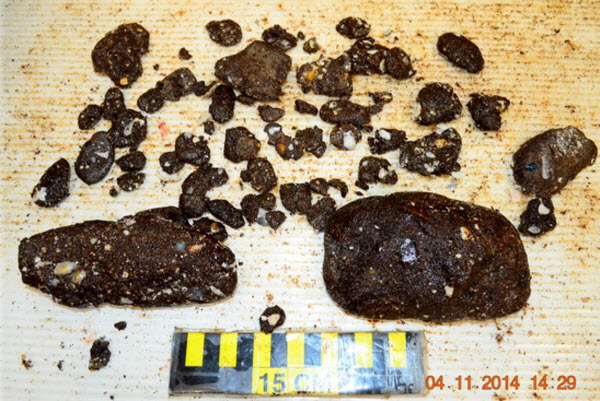http://neworleans.legalexaminer.com/toxic-substances/bp-the-real-state-of-the-gulf-pollution-report-for-friday-april-11-2014/
New Orleans, Louisiana
Posted by Tom Young
April 13, 2014 8:30 AM
Pensacola Beach was searched by Florida Department of Environmental Protection specialist Joey Whibbs on Friday, April 11, 2014. Whibbs collected 110 BP Deepwater Horizon tar balls weighing nearly three pounds. Photos courtesy FDEP.
The following is a summary of the 4/11/14 daily beach oiling report issued by the Florida Department of Environmental Protection (FDEP). I will endeavour to publish this summary each day the FDEP issues such a report. While the media and public believe that the effects of BP’s Deepwater Horizon Blowout and Oil Spill have been largely eradicated, this data suggests otherwise.
It is important to note that these reports of daily oil discoveries come at a time when BP is attempting to renege on its oft-stated “Commitment to the Gulf.” The company is repudiating the Contract it made with area businesses and individuals that compensates them for economic and environmental losses associated with BP’s spill.
Now BP claims that it is the victim. You be the judge, and if you are outraged, sign our petition to hold BP accountable, nearly four years after the company’s disaster.
My Summary of the Florida Department of Environmental Protection Oiling Report
Friday, April 11, 2014
On Friday, FDEP environmental specialist Joey Whibbs conducted a post-response monitoring survey on Escambia County, Florida beaches, with a focus in the Pensacola Beach area.
Numerous Surface Residue Balls (SRBs or “tar balls”) were found throughout the area.
These hardened balls are often filled with deadly, flesh-eating bacteria. Do not handle without protective gloves.
Friday’s findings indicate that oil from BP’s Deepwater Horizon spill is still quite prevalent. A total of 110 tar balls were collected during the survey, amounting to nearly three pounds of Deepwater Horizon oil product removed from these sections of beach – by one person.
Since the end of BP’s official cleanup efforts in June 2013, over 40,000 tar balls and 1,984 pounds of Deepwater Horizon oil have been documented and removed from Florida’s beaches alone (not including Alabama, Mississippi, Louisiana or Texas). On an average survey day, the FDEP team covers no more than 1,000 yards of beach, less than 1% of Florida’s shoreline that was impacted by the Deepwater Horizon oil spill.
Therefore, these numbers represent a very limited snapshot of residual oiling on Northwest Florida’s beaches.
For instance, this is an example of the ground covered in an average survey:
From this data, it appears BP has left town well before the job was done. So much for the company’s “Commitment to the Gulf.”
See below for images of some of Friday’s collected oil.
Portion of BP oil observed Friday, April 11, 2014 on Escambia County, Florida beaches. These hardened balls are often filled with deadly, flesh-eating bacteria. Do not handle without protective gloves.
Special thanks to Richard Charter
